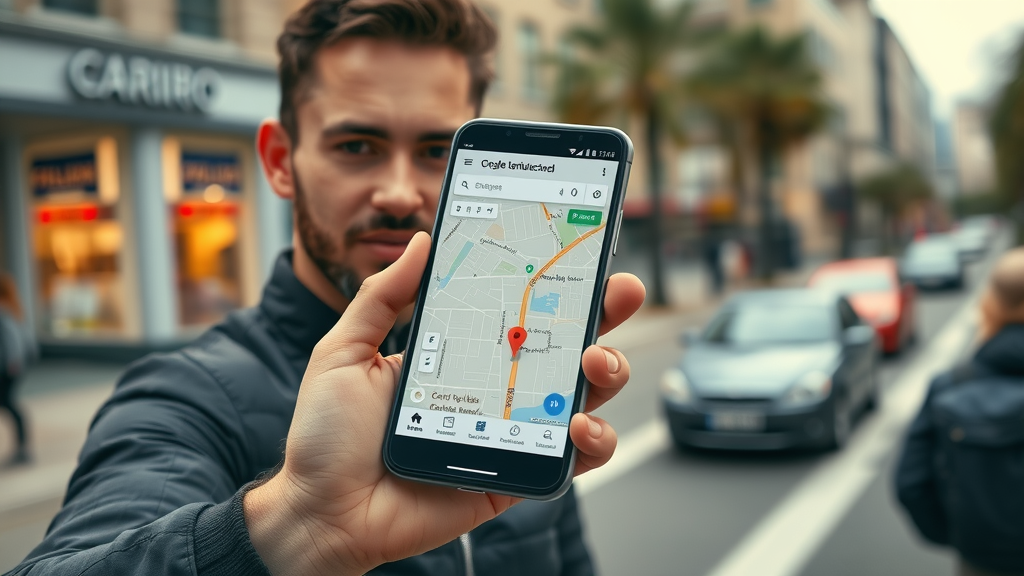Startling fact: Did you know that 78% of local mobile searches result in an offline purchase? This isn’t just a stat—it’s a wake-up call for small business owners. As we approach 2025, winning new customers starts with mastering local SEO and optimizing your Google Business Profile . This guide uncovers everything you need to know to dominate your local market and rise above competitors in search engine results.
Surprising Facts: Why Local SEO Is No Longer Optional for Google Business Profiles
- Did you know that 78% of local mobile searches result in an offline purchase? Uncover why local SEO is the single most important factor for Google Business Profile success in 2025.

Local SEO has transformed from a nice-to-have to a true business necessity. In 2025, failing to focus on local search means you’re leaving revenue on the table. Businesses showing up in the local pack —the top results you see in Google Maps—enjoy higher credibility and trust, leading to direct foot traffic and real-time sales. Moreover, consumer behavior is shifting to “near me” searches more than ever before. As mobile searches spike, appearing prominently in local search results is crucial for attracting potential customers. Google Business Profiles have become the digital storefront for small businesses; if yours isn’t up to par, your competitors will win those valuable clicks and calls.
Consider this: ranking high in local searches not only increases visits but also boosts your reputation through positive reviews and consistent business information. For every business owner aiming for local dominance , optimizing your Google Business Profile and prioritizing local SEO is no longer a choice—it’s a critical growth driver for 2025 and beyond.
Unlocking Success: What You’ll Learn About Local SEO and Google Business Profiles in 2025
- Crucial local SEO elements to dominate local search results
- How to optimize your Google Business Profile for improved local rankings
- The latest ranking factors every small business should know
- Actionable strategies for standing out in the local pack
This comprehensive guide gives you a step-by-step look into the essential strategies and tools that’ll set your small business apart. From understanding local SEO foundations to leveraging new Google Business Profile features, you’ll discover proven tactics to increase visibility, drive more foot traffic, and maximize your local ranking in search engines. Whether you’re new to engine optimization or ready to fine-tune an existing profile, you’ll equip yourself with techniques to future-proof your online presence and convert local searches into loyal customers.
Prepare to transform the way you tackle local ranking and ensure every detail in your business profile works in your favor. By the end of this article, you’ll be ready to implement winning strategies, track their impact, and stay ahead of evolving local SEO trends in 2025.
As you explore the nuances of optimizing your Google Business Profile, it’s helpful to understand how local SEO compares to broader organic SEO strategies. For a deeper dive into the differences and how each approach can impact your business growth, check out this detailed comparison on Local SEO vs Organic SEO .
Understanding Local SEO: The Essential Foundation for Small Business Growth
Defining Local SEO and Its Impact on Google Business Profiles
- What is local SEO?
- How local SEO drives local search visibility for local businesses

Local SEO is the specialized process of optimizing your online presence to attract more business from relevant local searches on search engines such as Google. For a small business , this isn’t just about being visible—it’s about being discoverable by customers who are ready to buy within your service area. Local SEO strategies bridge the gap between digital visibility and real-world results by ensuring your business appears in Google Maps and local search results.
Your Google Business Profile acts as the digital face of your business. A well-optimized profile not only provides essential business info—such as your business name, address, phone number , and hours—but also highlights your offerings, collects trustworthy reviews, and helps differentiate you from the competition. When your local SEO connects with Google’s algorithms, your profile ranks higher, meaning more eyes on your listing and more visitors through your door.
Understanding how local keyword targeting, citation consistency, and customer engagement fuel your ranking factors is vital. By leveraging these tools, a local business can transform its profile into a magnet for high-intent, local searches and outperform larger competitors in their neighborhood.
Why Google Business Profile Optimization Is Critical for Local Search Ranking Factors
Optimizing your Google Business Profile is central to outperforming other local businesses in search results. Google’s algorithms index every detail within your business profile, weighing elements like profile completeness, review quality, and citation accuracy as significant ranking factors. When properly managed, your business meets search engine expectations and appeals more to searchers, appearing in the coveted local pack.
In 2025, the importance of regularly updating your Google Business Profile can’t be overstated. Posting updates, uploading new photos, and maintaining up-to-date business info signals trustworthiness to both potential customers and search engines. Businesses that leverage all available features—such as product highlights, automated messaging, and booking tools—will enjoy better local rankings, increased traffic, and improved customer confidence.
Ignoring optimization often results in missed ranking opportunities, inconsistent information, and negative customer perception. Make local SEO and profile accuracy the foundation of your search engine optimization strategy to achieve consistent results and steady growth in your market.
The Anatomy of a High-Performing Google Business Profile for Local SEO
Key Features Every Local Business Must Optimize in 2025
- Business name, description, categories
- Accurate NAP (Name, Address, Phone Number)
- Business hours and holiday schedules
- High-quality images and videos

The most successful Google Business Profiles share common features. First, ensure your business name is consistent across search engines, directories, and your website. The profile description should be packed with relevant local keywords , accurately representing what you offer while attracting your target audience. Assign the correct categories to your business so you’re matched to local search queries and ranking opportunities are maximized.
Don’t overlook the importance of NAP consistency . This straightforward element influences your local ranking more than you might think. Double-check that your name, address, and phone number are identical anywhere your business appears online. Keep your business hours—including special holiday hours—current, as Google prefers fresh, reliable listings. Upload high-resolution photos and engaging videos to bring your profile to life; visuals drive user engagement and are now a Google ranking factor for local businesses.
Finally, use every opportunity to showcase your unique value, from service menus and product inventory to short videos and customer Q&A. Staying active with updates demonstrates responsiveness and encourages regular interaction with potential and existing customers—reinforcing your place atop local search results in 2025.
Google Maps and Local Business: Driving Foot Traffic with Local SEO

Google Maps is the go-to navigation and discovery tool for consumers on the move. Ranking well on Google Maps brings your small business right into the view of nearby customers who are ready to act. Optimized local SEO empowers your business profile to show up in “near me” searches and on the local map pack, turning digital impressions into real-world foot traffic.
To leverage Google Maps , ensure your business profile is verified, accurate, and full of fresh content. Use attributes, such as wheelchair access or outdoor seating, to boost relevancy and encourage customer visits. Encourage customers to leave positive reviews—these not only influence your local ranking but also make your location more appealing on the map.
Integrating your business listing seamlessly with Google Maps requires regular engagement. Post updates, respond to reviews, and quickly correct any business info discrepancies to maintain top placement. Maximizing your map visibility in 2025 means meeting customers where their search begins—on the go, on their phones, and actively searching for businesses like yours.
Ranking Factors: How Local SEO Determines Your Position in the Local Pack
| Ranking Factor | Description | Impact on Local SEO |
|---|---|---|
| Profile Completeness | Ensuring every section is filled | High |
| Review Score & Volume | Quantity & quality of reviews | High |
| Relevance | Category & keyword match | Medium |
| Proximity | Distance to searcher | Medium |
| GBP Updates | Frequency of new posts & updates | Medium |
| Photos & Videos | Visual media counts | Low |
Your ability to rank in the local pack boils down to several critical ranking factors . Profile completeness is a must: businesses that fully populate every section of their Google Business Profile send positive signals to search engines. The number and quality of reviews also carry weight; Google rewards this ongoing engagement with higher local search rankings. Relevance—using correct categories and local keywords—is what connects your listing to what potential customers are searching for.
Proximity matters too, as Google prioritizes businesses near the searcher in real time. Frequent updates on your business profile show you’re active, which boosts both trust and search engine perception. While photos and videos are less influential, they improve engagement rates and keep customers interested long enough for you to convert their intent into action. Understanding and prioritizing these factors will elevate your local SEO and strengthen your local search result performance throughout 2025.
Local Ranking Factors to Prioritize for Your Small Business in 2025
- Google business profile accuracy
- Local citations and NAP consistency
- Customer reviews and reputation management
- On-page signals and local keyword targeting
Prioritizing accuracy in your Google Business Profile is the starting point for any successful local SEO strategy . Double-check every detail you publish, and keep business info—such as location, phone number, and hours—updated everywhere your business appears online. Additionally, building citations (directory listings) that mirror your business profile ensures consistency, a top local ranking factor in the eyes of search engines like Google.
Active reputation management is another non-negotiable for 2025. Encourage reviews, respond to feedback, and address negative comments to show your commitment to customer service. Layer on targeted local keywords within your website’s content, landing pages, and profile descriptions to reinforce relevance and raise your chances of appearing in local search results. By mastering these foundational tactics, your small business will enjoy higher visibility in the crowded digital landscape.
The Role of Keyword Research in Local SEO for Google Business Profiles
Conducting Local Keyword Research: Tools and Strategies
- Identifying local keyword opportunities
- Using SEO tools like SEMrush, Ahrefs, and Google Keyword Planner

Keyword research is the backbone of a winning local SEO strategy . Start by identifying search terms your customers use to find businesses like yours, such as “best Italian restaurant near me” or “emergency plumber in [city].” SEO tools like SEMrush, Ahrefs, and Google Keyword Planner simplify the process; they uncover search volume, competition, and keyword trends specific to your location or industry.
When conducting research for your business profile , prioritize keywords that align with your core services, location, and customer intent. Don’t just aim for high monthly searches—focus on actionable, purchase-ready phrases that signal a high likelihood of conversion. Use these insights to guide everything from your profile description to new posts and FAQs within your Google Business Profile.
Remember, keyword research isn’t a one-time activity. The most successful businesses review their keyword lists regularly and adapt as trends shift. By leveraging advanced seo tools , you’ll always have fresh, relevant terms to power your local ranking efforts in 2025.
Strategic Placement: Integrating Local Keywords in Your Business Profile
Once you’ve completed local keyword research, strategic integration is the key to unlocking your profile’s full potential. Start with your business description—craft a compelling overview that naturally incorporates primary keywords without sounding forced or repetitive. Next, ensure fields like business category, service areas, and updates feature these keywords where relevant.
Consistency is vital: the same local keyword should appear across your website, citations, and within your Google Business Profile to reinforce your business’s relevance for target searches. Harness keyword-rich FAQs and posts to answer common customer questions and spotlight your offerings. The right balance between naturally written content and smart keyword inclusion is the secret to driving consistent local search result visibility.
Finally, combine keyword optimization with high-quality visuals and regular engagement. This holistic approach signals to both search engines and potential customers that your business is authoritative, relevant, and deserving of a top spot in local search rankings for 2025.
From Search to Store: How Local SEO Drives Actionable Results for Small Businesses
Tracking Local Search Results and Measuring Google Business Profile Performance
- Utilizing Google Search Console and Google Maps Insights
- Analyzing search result data for ongoing optimization

Measuring the impact of your local SEO efforts is non-negotiable for ongoing growth. Google Search Console provides insights into how your business appears in local search results, which queries drive the most traffic, and where users come from. Pair these metrics with Google Maps Insights to monitor actions like direction requests, website clicks, and customer calls from your profile.
Regularly reviewing this performance data allows you to spot trends, test new keywords, and refine your content to better match searcher intent. Look for spikes in specific search results , peaks in customer actions, and common feedback within reviews. Use these insights to double down on what’s working and adjust your strategy when performance dips.
By prioritizing data-driven optimization, you not only improve your Google Business Profile ranking but also enhance the customer journey from discovery to store. Consistent analysis and adaptation are the trademarks of small businesses that thrive in the digital era.
Local Search Strategies to Boost Engagement and Conversions
Maximizing engagement on your Google Business Profile starts with proactive communication. Use posts and Q&A to answer customer questions, highlight upcoming events, and announce new products—this keeps your listing fresh and encourages repeat visits. Encourage happy customers to leave reviews, and always respond—timely responses foster trust and demonstrate your commitment to excellent service.
Offer incentives for check-ins or reviews where possible, ensuring the process doesn’t violate Google’s guidelines. Leverage call-to-action buttons, such as “Book Now” or “Get Directions,” to streamline the customer journey from the search result to your door. Showcase visual proof of your work or atmosphere with updated galleries, fostering a personal connection and making a strong first impression.
Consistent local engagement, rapid response times, and strategic use of features put your small business ahead of the curve. In 2025, these tactics aren’t just “nice touches”—they are core drivers of increased conversions and long-term loyalty in the world of local SEO.
Latest Updates: 2025 Trends in Google Business Profile and Local SEO
New Features in Google Maps and Google Business Profiles
- AI-enhanced messaging & FAQs
- Automated booking integration
- Video content for business profiles

The future of local SEO is here, with Google rolling out AI-powered features designed to streamline customer interactions. In 2025, businesses can expect smarter messaging capabilities—think automated responses to FAQs and integration with chatbots for instant support. These innovations make your business more accessible, prompt, and capable of converting leads outside of traditional operating hours.
Automated booking integrations allow customers to schedule appointments directly from your business profile, reducing friction and boosting conversions. The debut of native video uploads provides a dynamic way to share your story, highlight services, or deliver timely promotions. Businesses that embrace these new features will outpace competitors, ranking higher and building deeper customer relationships in the increasingly digital-first market.
Stay informed and experiment with each update as it rolls out. Every enhancement is an opportunity to improve your local SEO standing and ensure your business remains at the forefront of local search results for years to come.
Adapting Your Local SEO Strategy for Future-Proof Rankings
To secure ongoing local ranking success, your SEO strategy must evolve with the latest Google updates. Emphasize continuous optimization—regularly check your profile for new features, test emerging content formats like video, and refine keyword targeting as trends shift. Flexibility is key; businesses that adapt rapidly are rewarded with stronger placements and more loyal customers.
Leverage automation tools to monitor reviews, detect inconsistencies, and deliver prompt updates across all directories. Build a feedback loop with your team or marketing partner to spot gaps, respond to changes in search engine algorithms, and capitalize on fresh growth opportunities. Looking ahead, a commitment to innovation and hands-on engine optimization will set you apart in the fiercely competitive world of local SEO.
With every small adaptation, your business profile becomes more valuable—both to potential customers and to search engines. Make staying ahead a core pillar of your marketing playbook and reap the benefits of steady visibility, increased engagement, and local dominance.
Expert Insight: Quotes from Leading Local SEO Specialists
"In 2025, businesses that prioritize local SEO and keep their Google Business Profile updated will win in both local search results and customer trust." – Jane Smith, Local SEO Consultant
"Local search is the bridge that connects digital discovery with physical visits. Optimizing your business profile is essential." – John Lee, Search Engine Expert
Essential Tools and Resources for Mastering Local SEO
- Moz Local
- BrightLocal
- Whitespark
- Google Business Profile Manager
Using SEO Tools for Ongoing Google Business Profile Optimization

Investing in the right seo tools unlocks new levels of efficiency for managing your local SEO campaigns. Platforms like Moz Local, BrightLocal, and Whitespark help small businesses monitor their NAP consistency, build citations, and analyze competitors. Google Business Profile Manager is a must-use, empowering you to make real-time updates and view advanced analytics.
Use keyword tracking modules to monitor your most valuable local search terms and adjust strategies as needed. Reputation management tools help automate the review request process and foster genuine feedback. By syncing these tools with your workflow, you’ll ensure that your business profile remains up-to-date, compliant, and optimized for every possible local ranking factor.
Regularly revisiting your tool stack, exploring new features, and adapting your processes to new data ensures your local SEO strategy remains bulletproof for 2025 and beyond.
A Step-By-Step Checklist for Optimizing Your Google Business Profile for Local SEO
- Claim and verify your Google Business Profile
- Complete every profile section with accurate local business details
- Add compelling photos and short videos
- Collect and respond to reviews
- Update business information regularly
- Use strategic local keywords in descriptions
- Monitor analytics and local search results
Follow this practical checklist to systematically elevate the visibility and appeal of your Google Business Profile. Each step is critical to maximizing your discoverability and ensuring every potential customer sees a trustworthy, dynamic, and professional business listing. Don’t let any area sit incomplete—full optimization is key to unlocking your position at the top of local search results in 2025.
Common Pitfalls: Mistakes That Hurt Local SEO and Local Ranking
- Inconsistent NAP across directories
- Neglecting reviews or failing to respond
- Outdated business hours or info
- Ignoring new features on Google business profile

Even the smallest oversight can derail an otherwise winning local SEO strategy. Inconsistent NAP (Name, Address, Phone Number) details across directories confuse both search engines and customers, leading to lower rankings and lost trust. Unattended reviews—especially negative ones—signal neglect and can tarnish your reputation, driving prospects to competitors.
Failing to update business hours or embrace new Google Business Profile features makes your profile appear stale, reducing the likelihood of strong local search performance. Always regularly audit every listing, keep business info current, and jump on new Google tools as they roll out. Avoid these common errors, and your local business will thrive throughout 2025.
Remember, attention to detail and responsiveness are the backbone of a high-performing local SEO campaign. Continually monitor, refine, and stay proactive to turn potential pitfalls into growth opportunities.
FAQs on Local SEO and Google Business Profiles
What is a local SEO?
Local SEO refers to the process of optimizing your business’s online presence to attract more business from relevant local searches. This includes improving your Google Business Profile, building local business citations, and targeting local keywords to increase visibility in local search results.
Is doing a local SEO worth it?
Yes, investing in local SEO is one of the most cost-effective strategies for small businesses. It can dramatically boost your business’s appearance in Google Maps and local search results, driving more foot traffic and growing your customer base.
How do I set up local SEO?
Set up local SEO by claiming your Google Business Profile, ensuring accurate NAP information, collecting customer reviews, optimizing for local keywords, and building citations across trustworthy directories.
Is local SEO free?
The basics of local SEO—such as optimizing your Google Business Profile and building citations—are free. However, advanced strategies and tools for local businesses may have costs associated.
Guided Video Tour: Optimizing Your Google Business Profile for Local SEO
- Step-by-step walkthrough using Google Business Profile dashboard
Video Explainer: Understanding Local Search Results and Ranking Factors
- Visual breakdown of how local businesses appear in local pack and local rankings
Video: How Keyword Research Powers Local SEO for Small Businesses
- Practical demonstration of keyword placement in a real business profile
Comprehensive List: The Top 10 Actions to Improve Your Local SEO in 2025
- Update business descriptions
- Add new photos monthly
- Collect customer reviews
- Use local keywords
- Post updates regularly
- Check citation consistency
- Monitor insights data
- Respond to all reviews
- Use booking integrations
- Take advantage of Google Business Profile’s new features
Key Takeaways for Local Businesses: Outranking Your Competitors in Google’s Local Search Results
- Local SEO is indispensable for small businesses
- Google business profile optimization drives real-world results
- Staying on top of local ranking factors can transform your local search results
People Also Ask: Expanding Your Local SEO Knowledge
What is a local SEO?
- Local SEO refers to the process of optimizing your business’s online presence to attract more business from relevant local searches. This includes improving your google business profile, local business citations, and targeting local keywords to increase visibility in local search results.
Is doing a local SEO worth it?
- Yes, investing in local SEO is one of the most cost-effective strategies for small businesses. It can dramatically boost your business’s appearance in google maps and local search results, driving more foot traffic and growing your customer base.
How do I set up local SEO?
- Set up local SEO by claiming your google business profile, ensuring accurate NAP information, collecting customer reviews, optimizing for local keywords, and building citations across trustworthy directories.
Is local SEO free?
- The basics of local SEO—such as optimizing your google business profile and building citations—are free. However, advanced strategies and tools for local businesses may have costs associated.
Take Your Local SEO to the Next Level in 2025
- Ready to grow your business? Book your free marketing strategy session with our team today. https://aaronmills.marketing/

Achieving Local Dominance: The Final Word on Google Business Profiles and Local SEO
- By following the latest tactics in local SEO, leveraging every aspect of your Google Business Profile, and consistently monitoring your rankings, your local business can achieve steady growth, increased visibility, and a competitive edge in 2025 and beyond.
If you’re ready to build on your local SEO momentum, consider expanding your knowledge of foundational SEO concepts that underpin every successful strategy. Mastering the essential terminology and understanding how each element fits into the bigger picture can empower you to make smarter decisions and communicate more effectively with your team or agency. For a practical glossary and actionable explanations, explore this guide to mastering basic SEO terms . Deepening your expertise now will set you up for even greater results as you continue to optimize your Google Business Profile and local presence in 2025.
To enhance your understanding of local SEO and its critical role in optimizing your Google Business Profile, consider exploring the following resources:
-
“What Is Local SEO and How to Improve Your Local Ranking” : This article provides a comprehensive overview of local SEO strategies, including practical steps to boost your local search rankings. ( sproutsocial.com )
-
“How to Improve Local SEO: 11 Best Practices” : This guide outlines effective practices for enhancing your local SEO efforts, such as creating locally relevant content and optimizing for mobile users. ( semrush.com )
By delving into these resources, you’ll gain valuable insights and actionable strategies to strengthen your local SEO approach and improve your business’s visibility in local search results.
 Add Row
Add Row  Add
Add 



Write A Comment